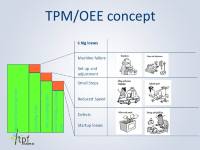TPM Zero Loss Analysis and OEE: Overall Equipment Effectiveness
A Zero Loss Analysis involves all aspects of the organization: safety, illness rate, late deliveries (customer), quality and environmental losses etcetera. The losses in administrative processes as well as the losses in production are taken into account.
When we realize that in many factories, the valuable operating time expressed in terms of OEE Overall Equipment Effectiveness is less than 50% of the gross available hours per year, it is obvious that our assets are not sweating. Part of this is caused by scheduled downtime, which includes holidays, no production planned due to limited load, spare capacity to cope with volume flexibility etcetera. The other part is caused by the fact that we do not produce fully efficiently. The reasons for this can be categorized into the TPM six big losses. These losses can be influenced during development and production.
Total Productive Maintenance is THE approach to improve your OEE Overall Equipment Effectiveness in a structural manner.
TPM focusses on improving the efficiency of the Planned Loading Time. The gap (losses) between 100% and actual efficiency can be divided into 3 categories:
- Availability: Breakdowns and changeovers indicate situations where the line is not running while it should be
- Performance: Speed losses and small stops/idling/empty positions indicate the line is running, but is not providing the quantity it should.
- Yield (Quality Rate): when the line is producing products, there are losses due to rejects and start-up quality losses
The Overall Equipment Effectiveness or OEE indicator is like the thermometer for your improvement potential. Total Productive Maintenance helps to improve the OEE by providing a structure to quantify these losses, and by subsequently giving priority to the most important ones. TPM provides concepts and tools to achieve both short and longer term improvements.
OEE Overall Equipment Effectiveness Index: OEE calculation
The OEE index has been developed by the JIPM (Japan Institute for Plant Maintenance). It is one of the pillars within the TPM method. The method distinguishes 6 loss types, and 3 categories: availability, speed losses and quality rate. The method's strength is that it makes the losses more transparent, and from experience we know that a good analysis provides a very good "picture" of the actual situation, which helps to determine both short and longer term improvement activities, including quantified benefits from each of the improvements.
OEE Definition
Gross Available hours
Gross Available hours (#days/year: 365, 24 hours/day, 7 days/week)
Planned Downtime
For example: vacation, holidays, not 168 hours/week, not enough load. (Sometimes it is stated that for example working in three shifts is a sales issue, and that the remaining time should not be taken as planned downtime. This is a complicated discussion and very much depends on the specific situation: we shall not elaborate that here)
1. Breakdowns/Machine failures
Downtime because of machine failures, as a rule of thumb usually an unplanned stop longer than 5 minutes where a technician is needed to resolve the issue.
2. Setup and adjustment
For example between product types, including "warmup time" after the actual changeover. Changeover time should be included here, and should not be included in the planned downtime. Changeover time can be reduced by applying the SMED system.
3. Small stops
When these have not been caused by logistics. Small stops are typically shorter than 5-10 minutes. Small stops are typically minor adjustments, for example cleaning a sensor. This in contrast with machinefailures, where you will usually need maintenance personnel to solve it.
4. Speed losses
Speed losses are caused when a machine runs more slowly than its optimal/maximum speed.
5. Rejects during production
This includes all rejects and repairs during normal production, so after running in/warmup phenomena.
6. Rejects during running in/ warmup
This includes all rejects and repair during startup/running in/ warmup.
OEE Calculation
Availability
Suppose the total planned production time is 3 shifts: 3 x 8 hours x 5 days = 120 hours.
We have 5 hours unplanned downtime due to machine failueres, and 7 hours changeover, this totals 12 hours.
The Availability then is: (120-5-7)/120 = 90%.
Performance
The actual operating time is 120 hours - 12 = 108 hours. The other twelve hours the machine is not running due to the above mentioned items. Suppose we lose another 20 hours in small stops and speed loss. The performance then is: (108-20)/108 = 81.48%
Yield (Quality Rate):
Now suppose we have a 2% yield loss, rejects, quality defects, then the yield is 98%
OEE calculation
The OEE definition is: OEE = Availability x Performance x Yield. In this case: OEE = 0.90 x 0.8148 x 0.98 = 71.8 %
